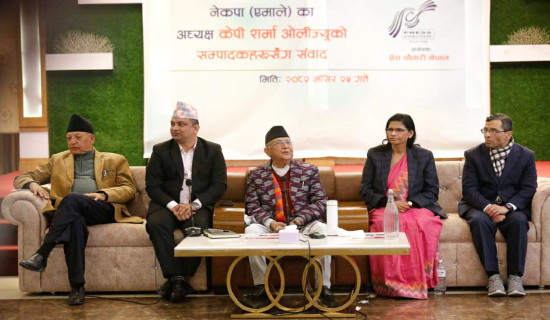- Thursday, 11 December 2025
Declining snowfall upsets life in mountains
Kathmandu, Mar. 17: Sonam Lama, aged 92, expressed disappointment as he pointed out the apple trees gone dry just below his house, attributing the shifting climate in and around his area over the last three decades.
When Sonam was young, winter in Helambu in Sindhupalchowk district was like a fairy tale. The snow fell profusely, wrapping everything in a soft, white blanket that reached up to four or five feet high. The houses, made of strong wood and stone, kept everyone warm and cozy, shielding them from the icy chill outside.
Sonam, the eldest resident of Sermathan in Helambu Rural Municipality, recalled the days when the slopes were adorned with apple trees, and juicy apples were plentiful. “The apples grown there were renowned even in Kathmandu. However, now the trees stand dry, without any apples. In the past, villagers would embark on a three-day journey to Kathmandu to sell their apples. But today, the village is deserted, and the once-vibrant community feels desolate,” Sonam said.
He shook his head sadly as he gazed out at the gray landscape. “There is no such snow anymore, mountains nearby look black,” he whispered. “Instead, we get light rain or moderate showers and very little snowfall just once or twice in the season.” He explained that many villagers had switched from growing apples to kiwi fruits. “The weather here is changing, and it seems to be more suited for kiwi than apple now,” he said.
When Poonam Lama arrived in Sermathan after getting married 20 years ago, from India, she was excited to experience the snowfall in the area. Staying inside the wooden houses was a new experience for her, and she never felt cold within them. But now, all the houses have been destroyed by the 2015 earthquake and replaced with structures made of cement, sand, and iron. Despite the absence of snowfall in the area, she started to feel cold inside these new houses, Poonam, a mother of three, said.
The situation is not only in Helambu but the dynamics of snow cover area (SCA) is witnessing across the country. A study conducted by various scientists to look at SCA and altitude changes in Nepal also showed that snow cover decreased over time.
A study entitled, “Dynamics and Maximum Snow Cover Area and Snow Line Altitude across Nepal (2003-2018),” using improved MODIS data showed altitude of snow lines also went up each year, especially in Eastern Nepal. Eastern areas had higher average snowline altitudes compared to Western and Central regions.
Decreasing snowfall
Dr. Sudeep Thakuri, a Climate Scientist and Associate Professor at the Central Department of Environmental Science, Tribhuvan University, noted a general trend of decreasing snowfall in Nepal’s mountains. Referring to the International Centre for Integrated Mountain Development (ICIMOD) report, Dr. Thakuri mentioned that in the Hindu Kush Himalayan (HKH) region, snowfall in the central mountains (Nepal) had decreased by 14 to 18 per cent, while the snowfall in the eastern and western mountains had increased by 10 to 12 per cent. Upon analysing the data, it was found that the overall volume of snowfall in the HKH remained similar, but a decrease was observed specifically in Nepal’s mountains.
Another study on “Tracing glacier changes since the 1960s on the south slope of Mt. Everest (central Southern Himalaya) using optical satellite imagery,” by Dr. Thakuri and team found that larger glaciers are losing area faster than smaller ones. While rising temperatures are a major factor, changes in the Asian monsoon may also be contributing. These glaciers are shrinking slower than others in the Himalayas due to their high altitude, but they are still retreating steadily over the past 50 years.
Other studies also showed that snow in certain river areas was found less because of changes in temperature and rainfall. The winters getting less snowy, which affected how water flowed. Snowline altitudes (SLA), which show where snow is, are affected by weather and land. Most snow comes in winter, and summer snow is only on highland. After the rainy season, there is hardly any snow left, which affects how water flows in spring. This study wants to see how it snows now and how it affects water in Nepal.
Dr. Arun Bhakta Shrestha, Senior Climate Change Specialist at ICIMOD and Programme Manager of the River Basins and Cryosphere Regional Programme, highlighted that the rising temperatures are causing a decline in snowfall and an increase in rainfall in mountainous regions. He said, “Rainfall is now being recorded even at high altitudes. During the winter, there is no rainfall, but in the pre-monsoon period, rainfall occurs instead of snowfall in the high mountainous areas.”
Impact of low snowfall
Climate Change expert Ngmindra Dahal said that the pattern of snowfall is shifting to higher altitudes, affecting traditional agriculture in the midhills.
He added, “Crops and fruits of cool climate are disappearing, and the sweetness in fruits and crops attributed to snowfall is no longer present. And also the crops and fruits are being affected by insects in lack of snowfall,” he said.
The global temperature is rising rapidly. The World Meteorological Organization (WMO) has officially confirmed that 2023 was the warmest year on record by a significant margin. This temperature increase has a profound impact on countries like ours, experts said.
According to Copernicus Climate Change Service, in February 2024, the global temperature reached record highs, marking it as the warmest February on record. The average ERA5 surface air temperature was 13.54 degrees Celsius, which is 0.81 degrees Celsius above the February average from 1991 to 2020, and 0.12 degrees Celsius higher than the previous warmest February in 2016.
Dr. Shrestha explained that rather than accumulating on the surface, snow melts due to rising temperatures. If the land is unable to absorb the moisture for an extended period, it flows down to the lowlands, potentially leading to natural hazards, erosion, and impacting the entire ecosystem.
Dr. Thakuri mentioned that while there is no large-scale study on snowfall, small-scale studies indicate a decrease in precipitation in the Koshi Basin. Contrary to global models showing an increase in precipitation, Nepal is experiencing a decrease, with a reduction also observed in distribution.
The low snowfall and precipitation have a significant impact on the irrigation system. The absence of timely snowfall and rainfall affects the local climatic system as a whole, he added.
According to a report of ICIMOD, studies indicate that at lower elevations, glacial retreat is not expected to cause significant changes in water availability over the next few decades. However, factors such as groundwater depletion and increasing human water usage could have a more pronounced impact. In higher elevation areas, continued glacial retreat may lead to altered water flow in certain river basins. On the other hand, the changes in the location, intensity, and alteration of rain and snow resulting from climate change are anticipated to have a greater effect on regional water supplies and groundwater recharge than glacial retreat.
Way forward
According to experts, developing alternative water sources, such as rainwater harvesting, desalination, and wastewater reuse, can help alleviate pressure on traditional water sources and enhance water security. Promotion of climate-resilient agriculture such as encouraging the adoption of climate-smart agricultural practices, drought-resistant crops and precision irrigation, can help farmers adapt to changing water availability patterns.
















